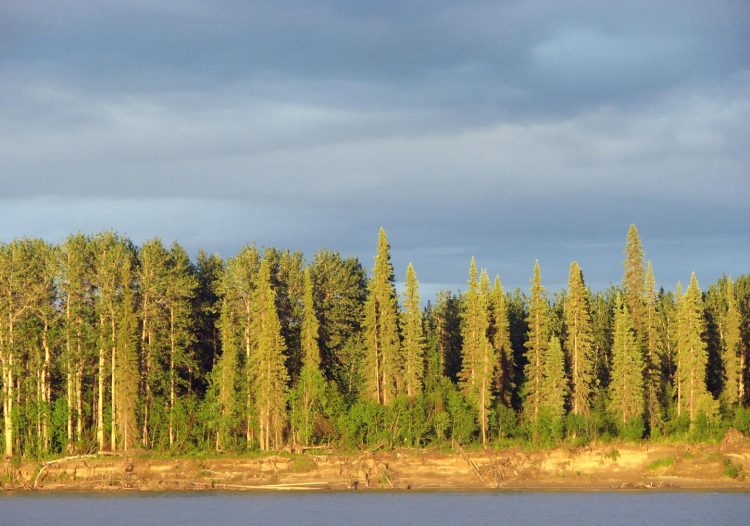Study: changing climate prompts boreal forest shift

Floodplain white spruce stand along lower Yukon River, late at night near the summer solstice in 2007. Courtesy of Photo by Claire Alix
The findings are the result of a study led by University of Alaska Fairbanks School of Natural Resources and Extension researcher Glenn Juday, Claire Alix of the University of Paris 1 Pantheon-Sorbonne, and Tom Grant, formerly an adjunct faculty member at UAF. Their findings were recently published online by the journal Forest Ecology and Management.
'For the first time across a major forest region, we have real data showing that biome shift has started,' Juday said. 'This is not a scenario model, or a might, or a maybe. The boreal forest in Interior Alaska is very near dying from unsuitably warm temperatures. The area in Western Alaska where the forest transitions to tundra is now the productive heart of the boreal forest.'
The paper is the result of 10 years of research. Juday and Alix gathered white spruce tree cores and disks from 540 trees in 36 stands along the Yukon, Tanana and Kuskokwim rivers. They started in easternmost Alaska and sampled downriver to the western edge of the boreal forest near the Bering Sea. The research required the team to travel hundreds of miles down some of the most pristine large rivers left on Earth. Sam Demientieff, a longtime Interior river traveler and Alaska Native leader, provided much of the river transportation and expertise required to navigate the silt-filled water and constantly shifting channels.
The researchers took two measurements from each annual growth ring of the 100 to 250-year-old trees, then analyzed the nearly quarter-million measurements to determine how much the trees grew each year. They then compared that growth to temperature data from eastern, Interior and Western Alaska historical records and weather stations. In addition, they drew on previous scientists' work chronicling tree growth and temperature back more than two centuries.
They found that in Interior Alaska, as summer temperatures rose, the growth of the trees slowed. Meanwhile, in Western Alaska, which is also warming, the trees are growing more rapidly.
White spruce trees thrive within an optimal temperature range. The long-term average temperature in Interior Alaska used to be at the high end of that optimum. In Western Alaska, the average temperature was below or at the low end of the optimal temperature range.
In the mid-1970s, temperatures suddenly increased and have cycled around a higher average since. Interior Alaska's average temperature became warmer than the trees' ideal range, and growth slowed. Meanwhile, the average temperature in Western Alaska increased to more closely match optimal conditions, which increased growth.
'One aspect of the study that makes the results especially clear is that the trees were all growing in the same environment along the big rivers,' Juday said. 'In many transect studies, lots of variables change across the area studied. In ours, the main thing that changed was the climate, from the hot, dry summers of the Interior, to the cooler, wetter climate near the coast.'
Juday notes that their findings don't mean the boreal forest is going away. It's simply shifting away from lowlands in Interior Alaska to higher elevations and the western part of the state, he said. 'The movement of an entire biome is often hypothesized in models of probable future climate, but the Alaska boreal forest is actually shifting today, and the process is well underway.'
###
Contacts:
Glenn Juday
907-474-6717
gpjuday@alaska.edu
Claire Alix
Claire.Alix@univ-paris1.fr
33-1-46-69-26-51
Note to editors: downloadable photos are available online at http://news.
Media Contact
All latest news from the category: Life Sciences and Chemistry
Articles and reports from the Life Sciences and chemistry area deal with applied and basic research into modern biology, chemistry and human medicine.
Valuable information can be found on a range of life sciences fields including bacteriology, biochemistry, bionics, bioinformatics, biophysics, biotechnology, genetics, geobotany, human biology, marine biology, microbiology, molecular biology, cellular biology, zoology, bioinorganic chemistry, microchemistry and environmental chemistry.
Newest articles

New organoid with all key pancreas cells
Researchers from the Organoid group (previously Clevers group) at the Hubrecht Institute have developed a new organoid that mimics the human fetal pancreas, offering a clearer view of its early development….

Unlocking the potential of nickel
New study reveals how to use single atoms to turn CO2 into valuable chemical resources. Nickel and nitrogen co-doped carbon (Ni-N-C) catalysts have shown exceptional performance in converting CO2 into…

‘Spooky action’ at a very short distance
Scientists map out quantum entanglement in protons. Particles streaming from collisions offer insight into dynamic interactions and collective behavior of quarks and gluons. Scientists at the U.S. Department of Energy’s…



